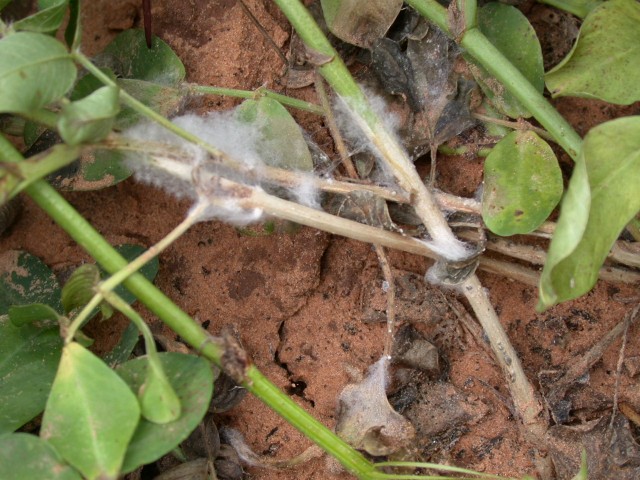
White Rot
Sclerotinia Sp.
Pathogen:
Fungus
Type:
Risk:
CRITICAL





DESCRIPTION
Pathogen description
Sclerotinia sp., also known as white rot, is a phytopathogenic fungus that affects a wide variety of plants, including ornamental and garden plants. This pathogen produces sclerotia, resistance structures that can survive in the soil for long periods of time, facilitating plant reinfection.
Disease description
The disease caused by Sclerotinia sp. In ornamental and garden plants it is mainly manifested by the presence of watery and soft Taches on the leaves, stems and flowers. These Taches can spread rapidly, acquiring a whitish color and cottony texture, resulting in decomposition of plant tissues. In addition, white sclerotia can be observed near the affected areas.

TEMPERATURE AND HUMIDITY
15°C - 25°C
70% - 90%

VOIES DE TRANSMISSION
Direct contact with infected sclerotia, spread by contaminated irrigation water, dispersion by wind.

Chemical treatments
CONTROL
• AZOXISTROBIN 25% [SC] P/V
• CIPRODINIL 37.5% + FLUDIOXONIL 25% [WG] P/P
• PHENHEXAMIDE 50% [SC] P/V
• PIRACLOSTROBIN 6.7% + BOSCALIDE 26.7% ( ) [WG] P/P
• PIRACLOSTROBIN 6.7% + BOSCALIDE 26.7% (I) [WG] P/P
Treatments authorized in organic farming
-
Biological control
• BACILLUS AMYLOLIQUEFACIENS subsp. plantarum (strain D747) 5% [SC] P/V
• BACILLUS SUBTILIS (STRAIN QST 713) 1.34% [SC] P/V
• PYTHIUM OLIGANDRUM (strain M1) 17.5% [WP] P/P
• TRICHODERMA ASPERELLUM (STRAIN ICC012) 2% + TRICHODERMA GAMSII (STRAIN ICC080) 2% (3 X 10E7 CFU/G (SUM OF BOTH MICROORGANISMS)) [WP] P/P
• TRICHODERMA ASPERELLUM (STRAIN T25) (1X10E8 CFU/G) 0.5% + TRICHODERMA ATROVIRIDE (STRAIN T11) (1X10E8 CFU/G) 0.5% [WG] P/P
• TRICHODERMA ASPERELLUM (STRAIN T34) 12% (1.0 x 10E12 cfu/kg) [WP] P/P
• TRICHODERMA ATROVIRIDE (STRAIN I-1237) (1x10E8 cfu/g) 5% [WP] P/P
Preventive treatments
• AZOXISTROBIN 25% [SC] P/V
• BACILLUS AMYLOLIQUEFACIENS subsp. plantarum (strain D747) 5% [SC] P/V
• BACILLUS SUBTILIS (STRAIN QST 713) 1.34% [SC] P/V
• CIPRODINIL 37.5% + FLUDIOXONIL 25% [WG] P/P
• PHENHEXAMIDE 50% [SC] P/V
• PIRACLOSTROBIN 6.7% + BOSCALIDE 26.7% ( ) [WG] P/P
• PIRACLOSTROBIN 6.7% + BOSCALIDE 26.7% (I) [WG] P/P
• PYTHIUM OLIGANDRUM (strain M1) 17.5% [WP] P/P
• TRICHODERMA ASPERELLUM (STRAIN ICC012) 2% + TRICHODERMA GAMSII (STRAIN ICC080) 2% (3 X 10E7 CFU/G (SUM OF BOTH MICROORGANISMS)) [WP] P/P
• TRICHODERMA ASPERELLUM (STRAIN T25) (1X10E8 CFU/G) 0.5% + TRICHODERMA ATROVIRIDE (STRAIN T11) (1X10E8 CFU/G) 0.5% [WG] P/P
• TRICHODERMA ASPERELLUM (STRAIN T34) 12% (1.0 x 10E12 cfu/kg) [WP] P/P
• TRICHODERMA ATROVIRIDE (STRAIN I-1237) (1x10E8 cfu/g) 5% [WP] P/P
To prevent and control white rot, it is recommended to practice proper crop rotation to reduce the accumulation of sclerotia in the soil. In addition, it is important to avoid excess watering and maintain good air circulation around the plants to reduce ambient humidity. The use of specific fungicides may be necessary in cases of severe infections.
Recommendations
*The recommended treatments are recommendations based on the authorities' databases and do not replace in any way the guidelines established by the legislation of each country.





